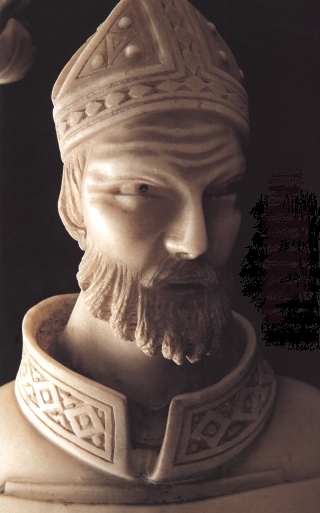Contenuto
Percorso : HOME > English > Pilgrims > Basilica of St. AmbroseThe Basilica of St. Ambrose: Tomb of St. Ambrose

Pavia: images of st. Ambrose
The Basilica of St. Ambrose: Tomb of St. Ambrose
In Book V of his Confessions, Augustine offers his reasons for moving from Rome to Milan. Yet writing his book several years later, he realizes that God had His reason for the move, a reason totally unknown to the young and ambitious rhetorician.
"A message had been sent from Milan to Rome, addressed to the prefect of the city, asking for a master of rhetoric. A pass had also been issued, authorizing the person chosen to use the official post-horses. Against the background of unsatisfactory student behavior I therefore canvassed support among citizens drunk on Manichean nonsense, in the hope that after prescribing a subject for a trial discourse the prefect Symmachus would recommend and dispatch me. My real reason for going was to get away from the Manichees, though this was not apparent either to them or to me at the time.
So I came to Milan and to Bishop Ambrose, who was known throughout the world as one of the best of men. He was a devout worshiper of you, Lord, and at that time his energetic preaching provided your people with choicest wheat and the joy of oil and the sober intoxication of wine. Unknowingly I was led by you to him, so that through him I might be led, knowingly, to you. " (Confessions V: 23)
The site on which the basilica of St. Ambrose is built was originally a cemetery area, outside the Vercellina Gate, where early martyrs for the Christian faith had been buried during the fourth century. After the Edict of Constantine in 313 A.D., Milanese Christianity gave birth to a flourishing of shrines and small chapels in honor of Milanese martyrs such as St. Vittore. It was close to the chapel of St. Vittore that St. Ambrose built his basilica between 379-386, dedicating it to the martyrs St. Gervasius and St. Protasius whose burial site had been discovered on June 17, 386, a few months before Augustine had his Tolle Lege experience in the garden.
The building, in early Christian style, had three naves separated by columns and arches, and an apse. Ambrose's intention was to prepare a tomb for himself under the altar canopied by a ciborium borne by four columns of porphyry, next to the tombs of Gervasius and Protasius. The love of the Milanese for their bishop led them from that time on to call the basilica of the martyrs the Basilica of St. Ambrose. St. Ambrose died on April 5, 397: on the next day, the mortal remains of the great bishop of Milan were placed on the left of the two martyrs whose bodies he had discovered.
Very little now remains of that original early Christian building: part of the walls, the four red porphyry columns, some bases of columns still in place in the nave, fragments of the wooden door, mosaic and marmoreal decoration and the inlaid marble. It was between the end of the IX and first half of the XII century that the edifice took shape in its essential lines as it is seen today. The Benedictine monks began a vast work of reconstruction of the Basilica at the end of the XVth century.
Archbishop Angilberto II (824 - 859) exhumed the bodies of the three patron saints, Ambrose, Gervasius and Protasius from their tombs and placed them together in a single urn and had it put over the original, tombs. He also had the splendid golden altar built, a masterpiece by Volvinio (c. 840). The altar panel facing the apse depicts episodes from the life of St. Ambrose. Connected to the Basilica is a very large Benedictine Monastery. Today, the Basilica of St. Ambrose still retains traces of all its past bistory. But in its architectural whole, it is a fruit of the golden age of Romanesque civilization as it blossomed in the Lombard work and in the Po valley in general.

